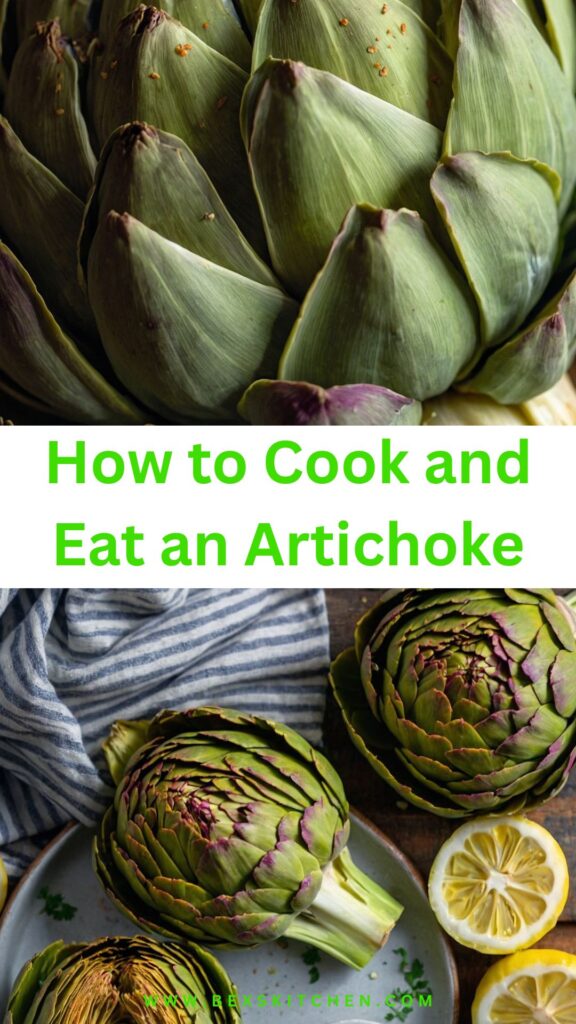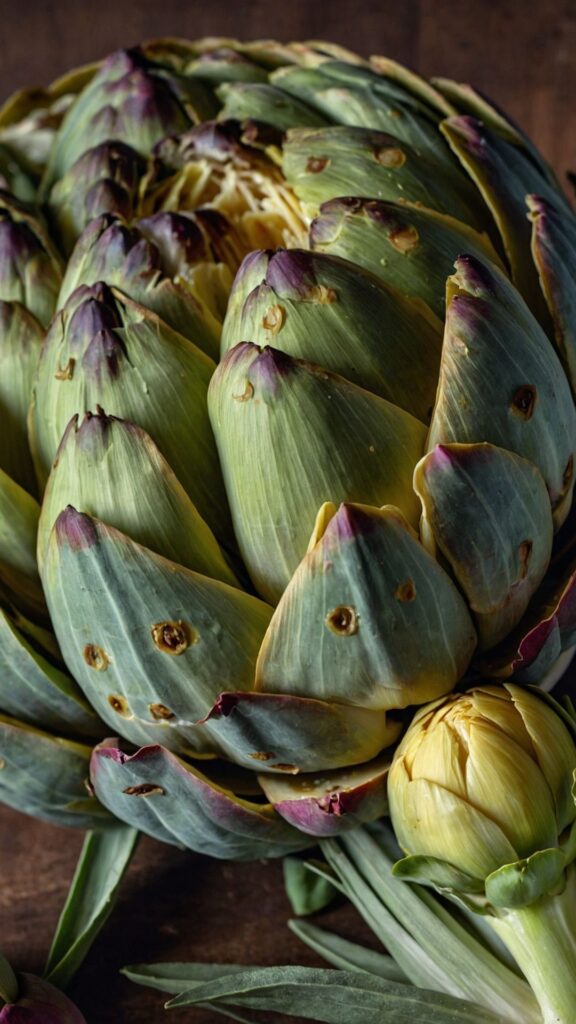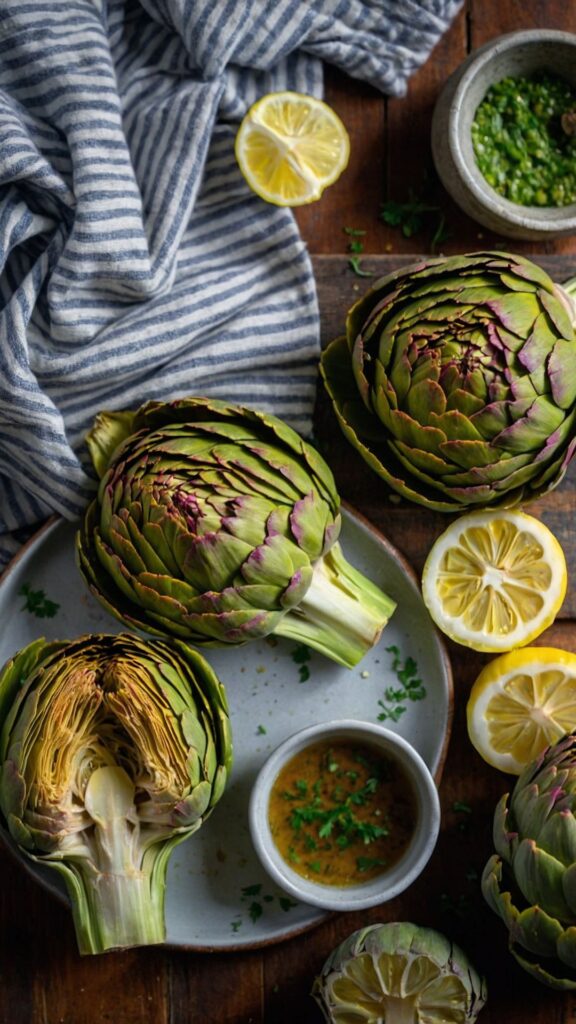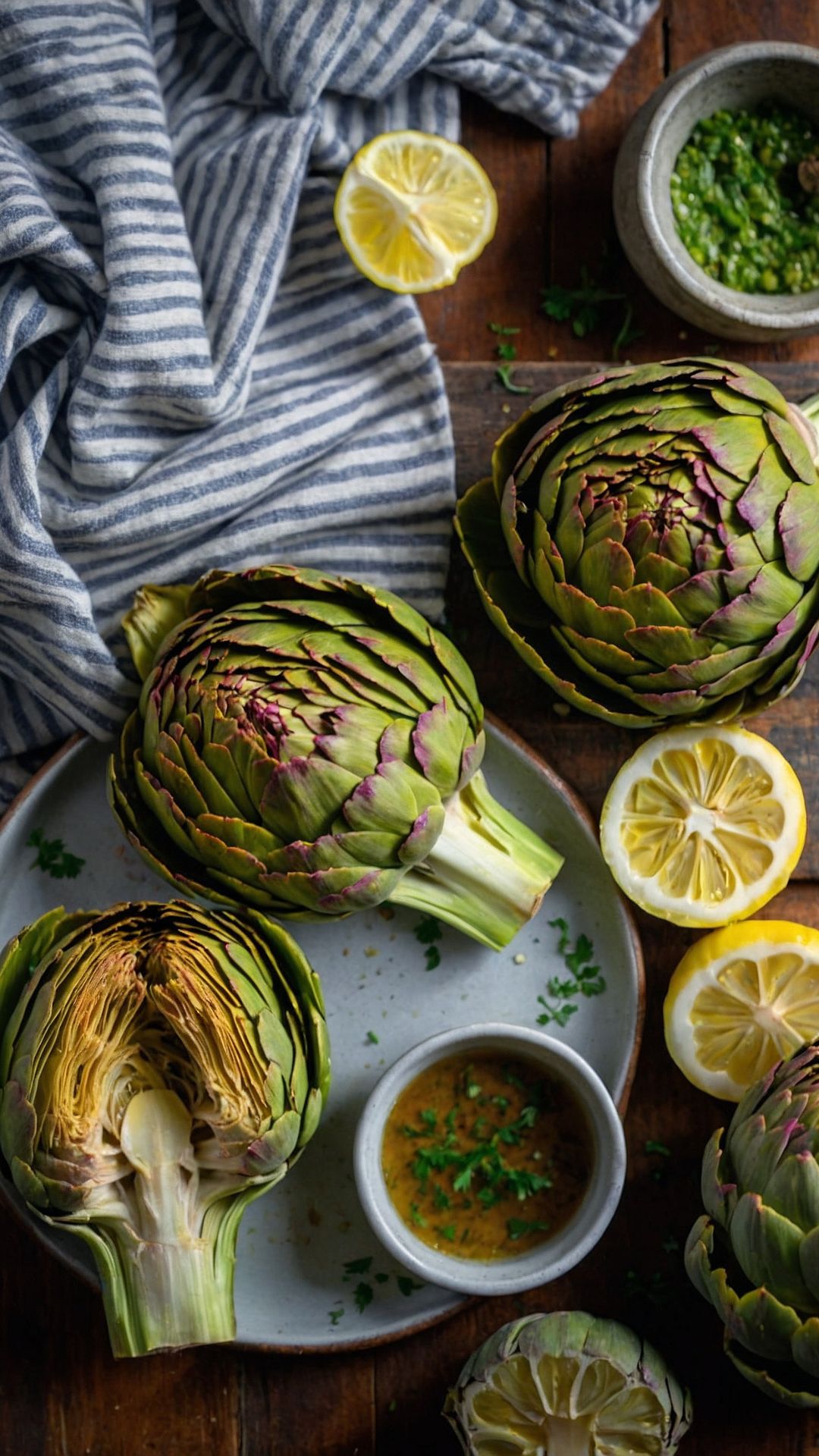When it comes to artichokes, the possibilities are as vast as the Mediterranean. Those delightful green buds pair beautifully with a variety of accompaniments. If you’re looking to elevate your dish, consider fresh lemon wedges, garlic aioli, or a classic vinaigrette. These options enhance the natural flavor of the artichoke and add extra zest.
For those who enjoy a heartier fare, grilled chicken or shrimp complements the artichoke’s unique taste while adding protein to your meal. A crisp white wine, like Sauvignon Blanc, can also make an excellent pairing, as the wine’s acidity contrasts perfectly with the artichoke’s buttery texture.

I’ll never forget the first time I cooked an artichoke. It was a sunny afternoon, and I was trying to impress a few friends with my culinary skills. As I stared at this prickly vegetable, I felt a mix of excitement and confusion. I had never dealt with anything like it before. Slowly but surely, I worked my way through the process, discovering a rather delightful treat hidden beneath those tough leaves. The experience became a memorable milestone in my culinary journey, showcasing the beauty of cooking something unfamiliar.
Here, I want to share everything I learned about cooking and eating artichokes. This vegetable is not just a dish—it’s an experience. Let’s dive into the ins and outs of preparing it, savoring its unique flavors, and enjoying it the way it’s meant to be enjoyed.
What is an Artichoke?
Artichokes are the immature flower buds of a thistle-like plant. They have a unique structure, with layers of tough leaves surrounding a tender core. When it comes to flavor, they possess a subtle, nutty profile. The heart, located at the center, is considered the most precious part. It’s creamy and rich, perfect for dipping and savoring with your favorite sauces.
You will also like the following Side Dishes recipes!
What is the Flavor Profile of an Artichoke?
The flavor of an artichoke is somewhat hard to pinpoint. It offers a combination of earthy, nutty, and slightly sweet notes. When cooked, the leaves soften, becoming tender but still firm, while the heart boasts a creamy texture that can stand up to a variety of flavors. Imagine biting into a steamed artichoke leaf, the slight bitterness gives way to a sweet richness, especially with a drizzle of lemon or a dip of garlic mayo. This versatility makes artichokes an exciting component of many dishes.
Why You’ll Love This?
If you’re looking to expand your culinary repertoire or impress guests, artichokes are both rewarding and unique. With a little know-how, you can prepare this vegetable into a dish that’s bound to be praised. Not only do they taste incredible, but they also pack a nutritional punch. High in antioxidants, fiber, and vitamins C and K, artichokes are beneficial for your health. They make you feel like a gourmet chef without the need for complicated techniques or hours in the kitchen.
Ingredients
To prepare a delicious artichoke, you will need the following ingredients:
- 1 fresh globe artichoke, trimmed. Make sure it’s vibrant with tightly closed leaves, indicating freshness.
- 1 small garlic clove, lightly crushed. This adds a subtle infusion of flavor.
- 1 lemon, cut into quarters. Use it for rubbing the artichoke and enhancing the flavor.
- 1 tablespoon extra-virgin olive oil. Helps in steaming or roasting while enriching flavors.
- Artichoke dipping sauce. This could be butter-based, aioli, or vinaigrette depending on your taste preference.

Step by Step Instructions
Step 1: Choose the Right Artichoke
First, pick artichokes that are firm and heavy for their size with tightly packed leaves. Avoid any that feel light or have dry, brown tips as they may be past their prime.
Step 2: Prep Your Artichoke
Trim the stem as needed, removing any tough, woody parts. Then, use a sharp knife or kitchen shears to cut off the top inch of the artichoke. This exposes the tender leaves and makes it easier to eat.
Step 3: Rinse and Drizzle
Hold your artichoke under cold water and give it a good rinse. This removes any dirt hiding in between the leaves. Next, drizzle olive oil over the top and give it a gentle rub to ensure it’s well-coated.
Step 4: Add Flavor with Garlic and Lemon
Take the crushed garlic and rub it into the leaves and the heart of the artichoke. This is your moment to infuse flavor! Then, take a lemon wedge and give your artichoke a light squeeze to add brightness. Toss the lemon wedge into the pot while cooking for an extra zing!
Step 5: Cook the Artichoke
You can steam the artichoke by placing it stem-side up in a pot with about an inch of water. Bring it to a boil, cover, and reduce to a simmer. Cook for about 25-40 minutes, depending on the size of the artichoke. You’ll know it’s done when a leaf pulls away easily.
Step 6: Prepare Your Dipping Sauce
While your artichoke is cooking, whip up a quick dipping sauce. Combine melted butter with minced garlic, or mix up a zesty aioli with mayo, lemon juice, and a dash of paprika. You can also go for a classic vinaigrette if you prefer something lighter.
Step 7: Serve and Enjoy
Once your artichoke is tender, remove it from the pot and let it cool slightly before serving. Present it with your favorite dipping sauce and wedges of lemon. To eat, pull off the outer leaves, dip them, and scrape the flesh with your teeth. Don’t rush; enjoy every moment.
Tips & Tricks
- Don’t Overcook: Keep an eye on the time as overcooking results in mushy, unpleasant artichokes. You want tenderness, but with some bite left.
- Store Properly: Store fresh artichokes in the fridge, wrapped in a damp paper towel, to prolong freshness.
- Experiment with Flavors: Try different dipping sauces; sundried tomato dip or hummus can be fantastic choices.
- Use a Pressure Cooker: If you’re short on time, a pressure cooker can dramatically reduce cooking time—just about 12 minutes will suffice!
- Save the Hearts: If you ever cook artichokes, don’t forget about the heart! The tender part can be used in salads, pastas, or on pizza.
Nutrition Information
A medium artichoke (without any dips or sauces) has about 60 calories, is high in fiber, and packed with vitamins and minerals, including Vitamin C and K. They offer significant health benefits, from support in digestion to protection against free radicals thanks to their high antioxidant content.
How Can You Store This?
Fresh artichokes can last in the fridge for about a week. To store them, keep them in a perforated plastic bag in the vegetable crisper of your fridge. Alternatively, if you only cook a portion of the artichoke, keep leftovers in an airtight container in the fridge. They are best consumed within a day or two.

Alternative Choices for Ingredients
If you find yourself missing some ingredients, here are some alternatives you can use:
- Olive Oil Swaps: If you don’t have extra-virgin olive oil, canola oil or avocado oil could work well. Each has a neutral flavor that won’t overpower the artichoke.
- Dipping Sauce Variations: If you don’t have butter for a dipping sauce, Greek yogurt mixed with garlic provides a creamy alternative that’s tangy and healthy.
- Absent Fresh Lemon?: If life hasn’t blessed you with fresh lemon, a splash of apple cider vinegar or lime juice can add a nice zing, albeit with a different flavor profile.

Equipment
- Woody exterior
Ingredients
- 1 fresh globe artichoke trimmed
- 1 small garlic clove lightly crushed1 lemon, cut into quarters
- 1 tablespoon extra-virgin olive oil
- Artichoke dipping sauce
Instructions
Step 1: Choose the Right Artichoke
- First, pick artichokes that are firm and heavy for their size with tightly packed leaves. Avoid any that feel light or have dry, brown tips as they may be past their prime.
Step 2: Prep Your Artichoke
- Trim the stem as needed, removing any tough, woody parts. Then, use a sharp knife or kitchen shears to cut off the top inch of the artichoke. This exposes the tender leaves and makes it easier to eat.
Step 3: Rinse and Drizzle
- Hold your artichoke under cold water and give it a good rinse. This removes any dirt hiding in between the leaves. Next, drizzle olive oil over the top and give it a gentle rub to ensure it’s well-coated.
Step 4: Add Flavor with Garlic and Lemon
- Take the crushed garlic and rub it into the leaves and the heart of the artichoke. This is your moment to infuse flavor! Then, take a lemon wedge and give your artichoke a light squeeze to add brightness. Toss the lemon wedge into the pot while cooking for an extra zing!
Step 5: Cook the Artichoke
- You can steam the artichoke by placing it stem-side up in a pot with about an inch of water. Bring it to a boil, cover, and reduce to a simmer. Cook for about 25-40 minutes, depending on the size of the artichoke. You’ll know it’s done when a leaf pulls away easily.
Step 6: Prepare Your Dipping Sauce
- While your artichoke is cooking, whip up a quick dipping sauce. Combine melted butter with minced garlic, or mix up a zesty aioli with mayo, lemon juice, and a dash of paprika. You can also go for a classic vinaigrette if you prefer something lighter.
Step 7: Serve and Enjoy
- Once your artichoke is tender, remove it from the pot and let it cool slightly before serving. Present it with your favorite dipping sauce and wedges of lemon. To eat, pull off the outer leaves, dip them, and scrape the flesh with your teeth. Don’t rush; enjoy every moment.
Notes
- Don’t Overcook: Keep an eye on the time as overcooking results in mushy, unpleasant artichokes. You want tenderness, but with some bite left.
- Store Properly: Store fresh artichokes in the fridge, wrapped in a damp paper towel, to prolong freshness.
- Experiment with Flavors: Try different dipping sauces; sundried tomato dip or hummus can be fantastic choices.
- Use a Pressure Cooker: If you’re short on time, a pressure cooker can dramatically reduce cooking time—just about 12 minutes will suffice!
- Save the Hearts: If you ever cook artichokes, don’t forget about the heart! The tender part can be used in salads, pastas, or on pizza.
Nutrition
Frequently Asked Questions
1. Can you eat the whole artichoke?
No, you cannot eat the entire artichoke. The leaves can be eaten by pulling them off and scraping the soft flesh with your teeth. The heart is the most prized portion, and the fuzzy part in the center, called the choke, should be discarded.
2. How do you know when an artichoke is cooked?
A properly cooked artichoke will have its leaves tender and easily pull away from the heart. A fork should pierce through the bottom easily, indicating it’s ready to eat.
3. Are artichokes healthy?
Yes! Artichokes are low in calories, high in fiber, and packed with antioxidants. They promote heart health, aid in digestion, and support liver function.
4. What is the best way to eat artichokes?
The best way is to pull off the leaves, dip them in your desired sauce, and scrape the flesh off with your teeth. Once you reach the heart, slice it up and savor its deliciousness.
5. Can artichokes be eaten raw?
Yes! Young artichokes can be thinly sliced and eaten raw in salads. However, the larger varieties are usually cooked for optimal taste and tenderness.
Conclusion
Cooking and eating an artichoke may seem intimidating at first, but I assure you it’s a delightful experience worth trying. With every step, you learn how to unlock flavors, texture, and a unique culinary skill that will impress family and friends alike. The artichoke is more than just a dish; it’s a journey into the world of food. So next time you’re at the grocery store, grab a few artichokes, and dive into this green treasure. You might discover it to be your new favorite. Happy eating!
